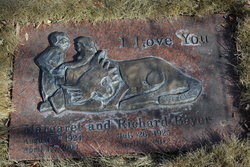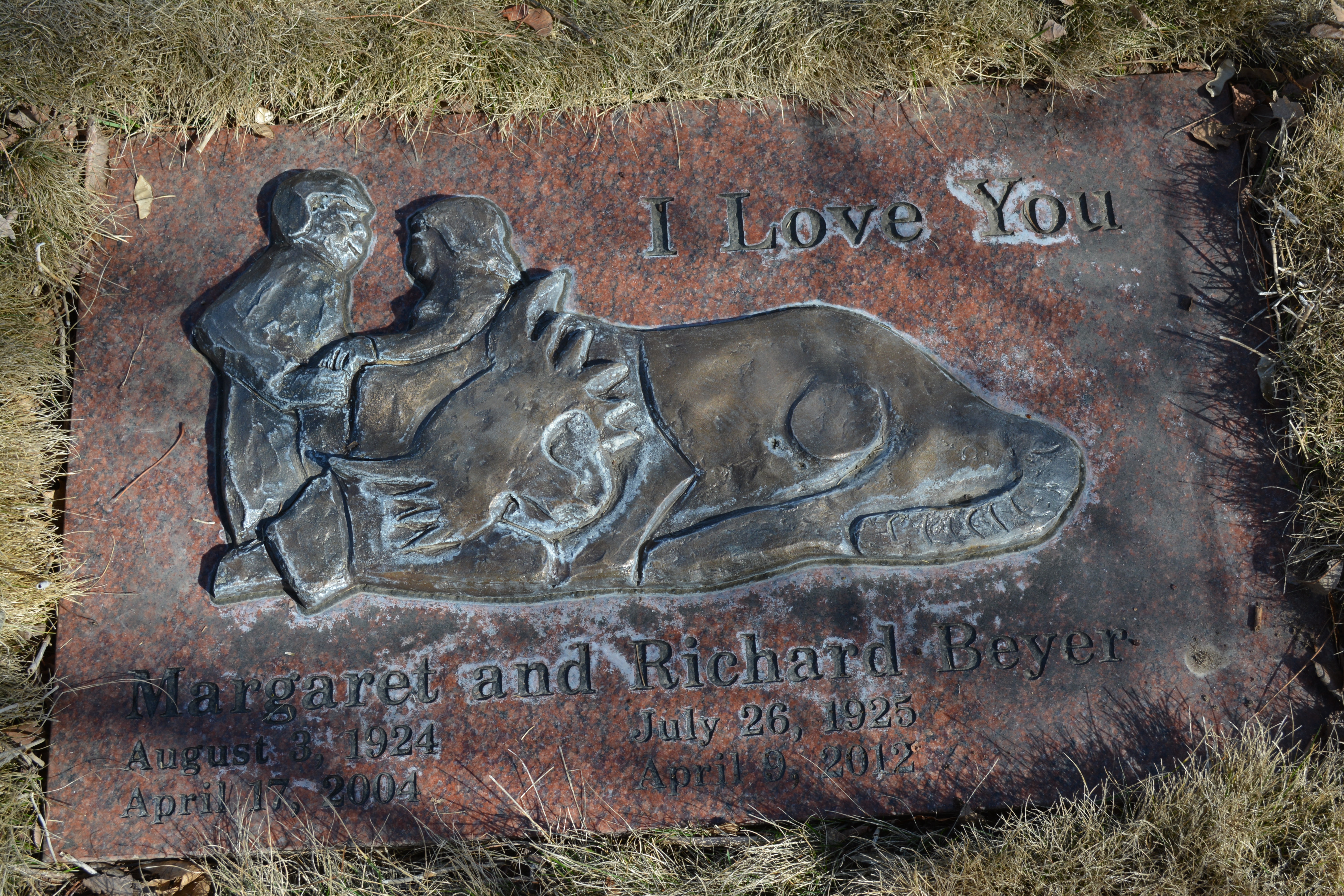On Monday, April 9th, 2012, Richard Sternoff Beyer passed away following a serious stroke he sustained on March 27th. Beyer is survived by his wife, Dorothy Scholz-Beyer, and his children Elizabeth Beyer Miller and Charles S. Beyer, and two step-children, Charles Scholz and Anna Scholz Godas, and 10 grandchildren and 1 great-grandchild.
A celebrated artist, Beyer is also survived by his inspiring and ground-breaking works – including many public art pieces. In a September 7, 2011 Fremocentrist.com column, Beyer was quoted, "My reputation started with the ‘Interurban'." Installation of the People Waiting For The Interurban came from Beyer's efforts, as a member of our community – and may well be the first public art work installed here. He gave us two other works – the ‘Reynard The Fox' Mural along Phinney Avenue at N. 35th Street and the Witch's Boots on N. 35th Street near Fremont Place N (with John Hoge) – before he moved his studio from Fremont to gain more space for his growing number of commissions.
Learn more about Beyer, and his art, in the book ‘The Art People Love' by Margaret Beyer.
A viewing and wake for the late artist will be held today, April 13th, in New York City. The funeral will be tomorrow, on April 14th at Noon, also in New York, at Holy Trinity Lutheran Church. The family has asked that memorials be sent to University Friends Meeting at 4001 – 9th Avenue N.E., Seattle, 98105-6410.
Printed by Kirby Lindsay in the Fremocentrist, Apr 13, 2012
Beyer—Richard Sternoff Beyer, 86, on April 9, 2012, in New York City, N.Y.
Rich was born on July 26, 1925, in Washington, D.C., to Clara and Otto Beyer. He married Margaret Wagenet in October 1948, and after receiving a Master's in Education from University of Vermont, he worked for two years for the Bureau of Economic Research in New York.
The family moved to Seattle in 1957, where Rich worked on a PhD in Economics at University of Washington. During this time he found his life's work and passion as a sculptor, carving in stone and wood. He joined University Meeting in Seattle in 1964, focusing especially on peace issues and serving on the Arts, Friends Center, Worship & Ministry, and Social Concerns Committees. He remained a member of University Meeting throughout the moves of his later life.
Rich told stories with his sculptures (one of which is carved on the cedar fence of University Meeting) that expressed his political views and Quaker values, often using humor. One children's climbing structure was a large cedar snag with holes containing carved heads of twentieth-century political leaders such as Churchill, Stalin, Mao, Nkrumah, Gandhi, and Roosevelt, which the children used to climb up to the top of the political world. Waiting for the Interurban (dedicated in 1978), in the Fremont area of Seattle, is probably Rich's best known and most beloved public sculpture.
The Peaceable Kingdom, commissioned by the Community Council of the Madrona area of Seattle and carved in 1984, alludes to the late 1960s and early 1970s when there were conflicts between young people of color in the neighborhood and the Seattle police, and the Black Panthers drilled on the Madrona playfield. The sculpture shows a wolf and a sheep, alluding to Isaiah 11:6-9, and a pig snuggling up to a panther in peace and reconciliation. Sometimes gruff and challenging, Rich did not follow rules, whether in school, art, or career, saying that he celebrated the things that make being alive worthwhile—family, friends, work, and caring—and mocked the things that debase us—greed, sloth, indifference, and complacency. He was always generous with aspiring young artists and people who did not fit into society's narrow expectations.
In 1988, Rich and Margaret moved to Pateros, Wash., where they were active in the Chelan-Methow Worship Group. Margaret wrote The Art People Love: Stories of Richard S. Beyer's Life and His Sculpture, Washington State University, 1999. Margaret died in 2004. In 2005, Rich moved to New York, where he married Dorothy (Dee) Scholz in 2007. In New York, Rich often accompanied Dee to Holy Trinity Lutheran Church, where her late husband had been pastor. There, in addition to the reading of the Isaiah "Peaceable Kingdom" passage, Rich's memorial included extended silence so that the congregation could hear the Holy Spirit moving and remember, rejoice, and renew the will to live in holiness and peace. Rich's life was also celebrated in Seattle after the Fremont Solstice Parade at the Fremont Arts Abbey. His family has developed a website to celebrate his work: www.richbeyersculpture.com.
Rich was preceded in death by his first wife, Margaret Wagenet Beyer. He is survived by his wife, Dorothy Scholz-Beyer; a daughter, Elizabeth Miller; a son, Charles Beyer; and his grandchildren.
--------------
http://www.richbeyersculpture.com/
On Monday, April 9th, 2012, Richard Sternoff Beyer passed away following a serious stroke he sustained on March 27th. Beyer is survived by his wife, Dorothy Scholz-Beyer, and his children Elizabeth Beyer Miller and Charles S. Beyer, and two step-children, Charles Scholz and Anna Scholz Godas, and 10 grandchildren and 1 great-grandchild.
A celebrated artist, Beyer is also survived by his inspiring and ground-breaking works – including many public art pieces. In a September 7, 2011 Fremocentrist.com column, Beyer was quoted, "My reputation started with the ‘Interurban'." Installation of the People Waiting For The Interurban came from Beyer's efforts, as a member of our community – and may well be the first public art work installed here. He gave us two other works – the ‘Reynard The Fox' Mural along Phinney Avenue at N. 35th Street and the Witch's Boots on N. 35th Street near Fremont Place N (with John Hoge) – before he moved his studio from Fremont to gain more space for his growing number of commissions.
Learn more about Beyer, and his art, in the book ‘The Art People Love' by Margaret Beyer.
A viewing and wake for the late artist will be held today, April 13th, in New York City. The funeral will be tomorrow, on April 14th at Noon, also in New York, at Holy Trinity Lutheran Church. The family has asked that memorials be sent to University Friends Meeting at 4001 – 9th Avenue N.E., Seattle, 98105-6410.
Printed by Kirby Lindsay in the Fremocentrist, Apr 13, 2012
Beyer—Richard Sternoff Beyer, 86, on April 9, 2012, in New York City, N.Y.
Rich was born on July 26, 1925, in Washington, D.C., to Clara and Otto Beyer. He married Margaret Wagenet in October 1948, and after receiving a Master's in Education from University of Vermont, he worked for two years for the Bureau of Economic Research in New York.
The family moved to Seattle in 1957, where Rich worked on a PhD in Economics at University of Washington. During this time he found his life's work and passion as a sculptor, carving in stone and wood. He joined University Meeting in Seattle in 1964, focusing especially on peace issues and serving on the Arts, Friends Center, Worship & Ministry, and Social Concerns Committees. He remained a member of University Meeting throughout the moves of his later life.
Rich told stories with his sculptures (one of which is carved on the cedar fence of University Meeting) that expressed his political views and Quaker values, often using humor. One children's climbing structure was a large cedar snag with holes containing carved heads of twentieth-century political leaders such as Churchill, Stalin, Mao, Nkrumah, Gandhi, and Roosevelt, which the children used to climb up to the top of the political world. Waiting for the Interurban (dedicated in 1978), in the Fremont area of Seattle, is probably Rich's best known and most beloved public sculpture.
The Peaceable Kingdom, commissioned by the Community Council of the Madrona area of Seattle and carved in 1984, alludes to the late 1960s and early 1970s when there were conflicts between young people of color in the neighborhood and the Seattle police, and the Black Panthers drilled on the Madrona playfield. The sculpture shows a wolf and a sheep, alluding to Isaiah 11:6-9, and a pig snuggling up to a panther in peace and reconciliation. Sometimes gruff and challenging, Rich did not follow rules, whether in school, art, or career, saying that he celebrated the things that make being alive worthwhile—family, friends, work, and caring—and mocked the things that debase us—greed, sloth, indifference, and complacency. He was always generous with aspiring young artists and people who did not fit into society's narrow expectations.
In 1988, Rich and Margaret moved to Pateros, Wash., where they were active in the Chelan-Methow Worship Group. Margaret wrote The Art People Love: Stories of Richard S. Beyer's Life and His Sculpture, Washington State University, 1999. Margaret died in 2004. In 2005, Rich moved to New York, where he married Dorothy (Dee) Scholz in 2007. In New York, Rich often accompanied Dee to Holy Trinity Lutheran Church, where her late husband had been pastor. There, in addition to the reading of the Isaiah "Peaceable Kingdom" passage, Rich's memorial included extended silence so that the congregation could hear the Holy Spirit moving and remember, rejoice, and renew the will to live in holiness and peace. Rich's life was also celebrated in Seattle after the Fremont Solstice Parade at the Fremont Arts Abbey. His family has developed a website to celebrate his work: www.richbeyersculpture.com.
Rich was preceded in death by his first wife, Margaret Wagenet Beyer. He is survived by his wife, Dorothy Scholz-Beyer; a daughter, Elizabeth Miller; a son, Charles Beyer; and his grandchildren.
--------------
http://www.richbeyersculpture.com/
Family Members
Sponsored by Ancestry
Advertisement
Advertisement







